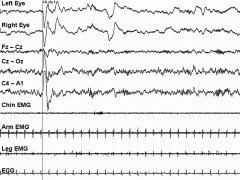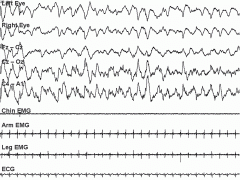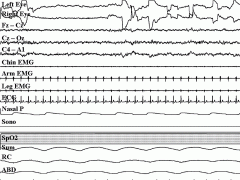![]()
![]()
![]()
Use LEFT and RIGHT arrow keys to navigate between flashcards;
Use UP and DOWN arrow keys to flip the card;
H to show hint;
A reads text to speech;
39 Cards in this Set
- Front
- Back
|
A normal night of adult sleep typically consists of how many cycles of REM and NREM sleep? |
Between 4 and 6 cycles, each lasting approximately 90 minutes |
|
|
N1 sleep is characterized by? |
1. Shift from alpha rhythm (8-13 Hz) to theta activity (4-7 Hz) 2. Vertex (V) waves with a duration of less than 0.5 s and maximal expression over the central head regions 3. Slow roving horizontal eye movements |
|
|
N2 sleep is defined by what EEG phenomena? |
1. K complexes 2. Sleep spindles |
|
|
What are K complexes? |

Waveforms with a well-delineated negative sharp wave immediately followed by a positive component with a duration of 0.5 seconds or longer, usually maximal when recorded over frontal derivations |
|
|
What are sleep spindles? |
Train of distinct waves with a frequency of 11 to 16 Hz (most commonly 12-14 Hz) and a duration of 0.5 s or longer |
|
|
Stage N3 sleep is characterized by? |

High-amplitude synchronized EEG activity with a frequency of 0.5 to 2.0 Hz |
|
|
REM sleep is characterized by? |

Asynchronous, low-amplitude, mixed-frequency EEG activity; rapid eye movements |
|
|
What are sawtooth waves? |
The only named waveform of REM sleep; a train of sharply contoured or triangular, often serrated 2- to 6-Hz waves |
|
|
Function of N3 sleep? |
Restorative and reparative state and plays an important role in numerous physiologic processes, including cognition, endocrine function and neuroimmunologic signaling |
|
|
What is the function of REM sleep? |
Remains unclear but probably include consolidation of procedural and spatial memory |
|
|
When are all named sleep-related waveforms generally present? |
By about 6 months |
|
|
Difference between sleep phases in neonates and adults? |
NREM and REM are referred to as quiet and active sleep respectively, and in the first few months of life, active sleep comprses approximately half of total sleep time, while the proportion of REM sleep declines and latency to the first REM period increases |
|
|
EEG of NREM sleep has their maximal expression over which regions during the different stages of NREM sleep? |
N1 - Central N2 - Central N3 - Frontal |
|
|
Affected neurons in a wake state |
All active |
|
|
Affected neurons in NREM sleep |
Cholinergic - Silent Noradrenergic - Partially active Serotonergic - Partially active Hypocretinergic - Silent |
|
|
Affected neurons in REM sleep |
Cholinergic - Active Noradrenergic - Silent Sertonergic - Silent Hypocretinergic - Silent |
|
|
Thalamocortical activity during wakefulness and REM sleep is characterized by what? NREM sleep? |
A state of tonic activation and desynchrony; a state of rhythmic, synchronized activity |
|
|
What is the role of calcium channels in state-dependent thalamic activity? |
The transient Ca2+ current, It, enables thalamocortical neurons to generate a tonic firing pattern when stimulated from a relatively depolarized state or a burst-pause firing pattern when stimulated from a relatively hyperpolarized state |
|
|
How can arousal networks promoting wakefulness be divided? |
1. Ascending system 2. Stabilizing system |
|
|
Which nuclei are included in the ascending systems? |
1. Cholinergic nuclei of midbrain and pontine stegmentum 2. Monoaminergic brainstem neurons 3. Monoaminergic hypothalamic neurons |
|
|
The stabilizing system consists of? |
Hypocretinergic neurons of the perifornical and posterolateral hypothalamus |
|
|
Which neurons are responsible for the relative depolarization keeping the It channels inactive during wakefulness? |
Pedunculopontine and laterodorsal tegmental nuclei of the cholinergic ascending arousal network; tonic single-spike firing in response to afferent input facilitates transmission of sensory information to the cortex |
|
|
Which neurons are involved in the monoaminergic ascending arousal system? |
1. Noradrenergic neurons of the locus coeruleus 2. serotonergic neurons of the midbrain dorsal raphe 3. Dopaminergic neurons of the ventral periaqueductal gray 4. Histaminergic neurons of the hypothalamic tuberomammillary nucleus |
|
|
Which targets are innervated by the monoaminergic ascending arousal system? |
1. Cerebral cortex 2. Wake-stabilizing systems of the posteriolateral and perifornical hypothalamus 3. Sleep-promoting centers of anterior hypothalamus and basal forebrain |
|
|
How do the monoaminergic nuclei comprise 1 arm of the flip-flop switch between sleep- and wake-promoting centers? |
Direct inhibitory influences over the NREM sleep-generating neurons of the ventrolateral preoptic nucleus (VLPO) and median preoptic nucleus (MnPN) |
|
|
Which neurons comprise the stabilizing arousal system? |
Neurons in the posterolateral and perifornical region of the hypothalamus; these neurons express hypocretin ( orexin) |
|
|
Encephalitic patients with severe insomnia often have lesions where? |
Areas involving the preoptic area of the anterior hypothalamus |
|
|
Depletion of _____ results in persistent hypersomnolence and ___ |
hypocretin nuclei of the posterolateral hypothalamus; intrusion of elements of REM sleep into wakefulness |
|
|
How is the hypocretin arousal system activated? |
Largely via glutaminergic input from the dorsomedial nucleus of the hypothalamus (DHM), which in turn is regulated by circadian inputs from the suprachiasmatic nucleus (SCN) and ventral subparaventricular zone |
|
|
The two most important brain regions fore generation and maintenance of sleep? |
1. Anterior hypothalamus (and adjacent basal forebrain) 2. Pontine tegmentum |
|
|
Specifically which brain regions are involved in the mediation of NREM sleep? |
Proptic nuclei of the anterior hypothalamus, including VLPO and MnPN |
|
|
Specifically which brain regions are involved in the mediation of REM sleep? |
Pontine tegmental nuclei, including the subcoeruleus region of the lateral nucleus reticular pontins oralis (NRPO) |
|
|
Which parts of the brain can be considered the somnogenic part of the flip-flop switch of wakefulness? |
The preoptic area nuclei, as well as the substantia innominata and diagonal band nucleus of the basal forebrain, as their widespread GABAergic and galaninergic projections inhibit the monoaminoergi, cholinergic, and hypocretinergic arousal nuclei |
|
|
Difference between VLPO neurons and MnPN neurons in firing pattern during sleep? |
VLPO most active during NREM, MNPN most active in early NREM, especially after prolonged wakefulness, suggesting MnPN activity induces NREM sleep, which VLPO then sustains |
|
|
What regulates the state transition between REM and NREM sleep? |
REM-on cells of the subcoeruleus region in the lateral NRPO and REM-off cells of other parts of the lateral pontine tegmentum and ventrolateral periaqueductal gray; these poles are mutually inhibitory |
|
|
What are the basic influences on sleep and wake patterns? |
1. Homeostatic 2. Circadian 3. Allostatic forces (unpredictable environmental influences) |
|
|
What is the primary function of the homeostatic force? What is it termed? |
Process S; maintain equilibrium between wake and sleep times, can be viewed as sleep debt |
|
|
Possible primary substrate for process S? |
Adenosine; may exert depolarizing or hyperpolarizing influence on target cell membranes, depending on the receptor subtypes |
|
|
What is a zeitgeber? |
Rhythmically occurring natural phenomenon which acts as a cue in the regulation of the circadian rhythm |

